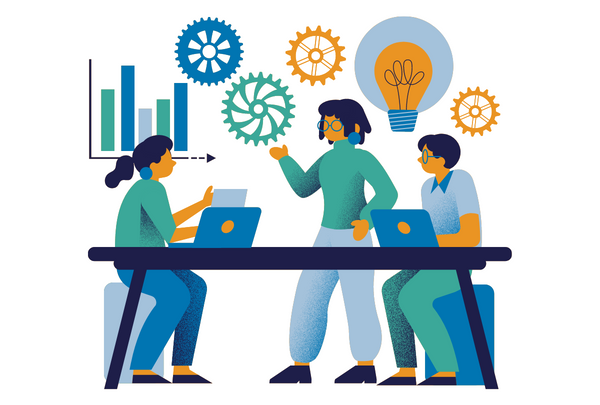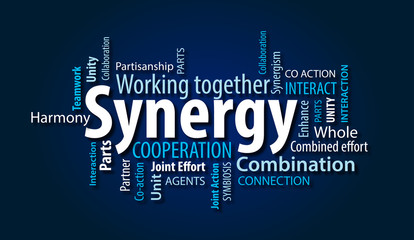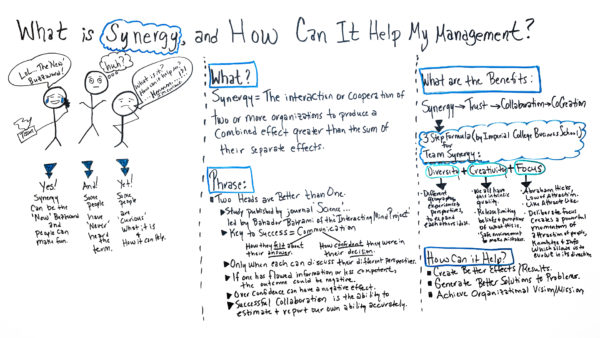Organization Synergy: Encouraging Collaboration in Agile Teams
By Team Lean Agile Intelligence

Organization Synergy and Collaboration in Agile Teams
The success of an organization largely depends on its ability to promote a sense of shared ownership and collaboration among its members, known as Organization Synergy. Promoting collaboration in agile teams can lead to increase productivity and effectiveness of team members.
In this post, we discuss the best practices of Organization Synergy. Following the foundational techniques at different stages of your learning journey, you can ensure to learn about the best strategies to bring back to the team. However, Organization Synergy is just one part of the big picture, if you want a holistic view of your team's current process status, take advantage of our free agile assessment for Organization Business Agility.
Organization Synergy and The Learning Journey
At Lean Agile Intelligence, we recognize Organization Synergy as the sense of shared ownership and collaboration among organization members. We divided the learning journey into 4 different stages: Developing, Emerging, Adapting, and Optimizing. In the following sections, we will discuss each stage in detail as well as provide practical tips and techniques to help you extend your skills in this area.

Source - Synergizing Agile Projects
Developing
An Organization "developing" an understanding of the value of Synergy and adopting the foundational techniques should focus on the following improvements:
-
The What: Organization members have a clear and shared understanding of the vision and goals of the products/initiatives they are working on
-
The How: Product ownership starts with a vision for the future. Steve Jobs once said “If you are working on something exciting that you really care about, you don’t have to be pushed. The vision pulls you.” Therefore, it’s the responsibility of the product owner to ensure there is a compelling and inspiring vision teams are working to accomplish. In this post, Roman Pichler outlines 8 tips for creating a compelling product vision.
-
Extended from a vision are product goals. Common industry practice is to use Objective and Key results to drive execution towards a vision. You can read more about that here.
-
-
-
The What: The organization uses a common language to describe their work
-
The How: Organization members should use the same terminology. This will reduce confusion and lead to a shared understanding. When introducing new processes or techniques via training, it's important that all Organization members are part of the training. Especially if the terminology may change.
-
-
The What: The organization has collaborative workspaces (on-site or remote) and utilizes collaboration tools for communication, sharing, and fun
-
The How: XP, or extreme programming, is an agile framework that predates the agile manifesto. In that framework, there is a practice called "Informative workspace." That practice is described as "A practice to build feedback mechanisms around an agile effort that supports them in their daily work. These feedback mechanisms can take the form of visual displays (Information Radiators) manually updated by the organization members or electronic eXtreme Feedback Devices (XFD) such as lava lamps or audio signals linked to automated processes. It is vital to ensure that feedback mechanisms are easy to interpret, low maintenance, and adapted to local practices." - Davies R Bacon.
-
The How: A collaborative in-person workspace starts with an informative workspace in which all members can view and contribute to up-to-date information and is expanded by utilizing in-person collaborative tools. Some basic but often effective tools would be whiteboards, sticky notes, flip charts, markers, etc. When working remotely, organization members have collaborative workspaces (on-site or remote) and utilizes collaboration tools for communication, sharing, and fun should strive to replicate the collaborative nature of these tools online. Some tools can even provide more real-time functionality than possible in a physical space. Two of the most popular tools are Miro and Mural, and you can also check out more tools for remote working environments here.
-
-
The What: Organization members know what each other are working on and ensure open lines of communication, alignment of efforts, and management of dependencies
-
The How: Clarity of roles is fundamental to building Organization synergy. You can use a working agreements canvas to drive the facilitation of roles and responsibilities. Some questions to ask…
-
Who is the Product Owner/Manager? The Lead Facilitator? The other team members? Is there single accountability for specific things? Is there a backup?
-
-

Emerging
An Organization "emerging" beyond the foundational techniques of Synergy and embracing it as they become more proficient should focus on the following improvements:
-
The What: Organization members know what each other are working on and ensure open lines of communication, alignment of efforts, and management of dependencies
-
The How: Clarity of roles is fundamental to building Organization synergy. You can use a working agreements canvas to drive the facilitation of roles and responsibilities. Some questions to ask…
-
Who is the Product Owner/Manager? The Lead Facilitator? The other team members? Is there single accountability for specific things? Is there a backup?
-
-
-
The What: Organization members listen to one another's opinions and consider tradeoffs
-
The How: A technique called "active listening" is more of an advanced topic for most organization members but can help take Organization Synergy to the next level. Here is a blog post that describes the technique in depth. A key takeaway:
-
There are five key techniques team members can use to develop active listening skills:
-
-
-
Pay attention.
-
Show that you're listening.
-
Provide feedback.
-
Defer judgment.
-
Respond appropriately.
* * * * * *
"Product ownership starts with a vision for the future."
* * * * * *
Adapting
An Organization "adapting" the behaviors that create Synergy, should focus on the following improvements:
- The What: Organization members are willing to play multiple roles to get things done, even if it means working outside of their function or domain
-
The How: In her book "Coaching Agile Teams," Lyssa Adkins teaches a technique called "Marketplace of Skills." The steps are as follows…
-
"Each team member is asked to draw up a personal skills market stall as part of a team skills marketplace.
-
The top of the counter is where they should make a note of all of the relevant skills they currently bring to the organization.
-
Underneath the counter is where they should make notes of any 'hidden' skills they have: these could be abilities they used for previous roles or careers, or maybe in their spare time or as a hobby. Depending on the Organization and the aim of the session, you can ask them to keep them professional or allow them to include anything they want to share.
-
They should also make a note (perhaps on different colored post-it notes) of any skills they would like to learn or improve.
-
When the Organization members have finished their stalls pin them all up on the wall to form the marketplace.
-
Organization members then playback their stall to other teams and members, with the others making notes of what skills might be helpful in their work, where they can help teach or mentor a new skill, or where a member may be able to help them improve a skill.
-
With Agile, we focus on building self-organizing, cross-functional team(s), so focus on what learnings you gain that can help the teams and organization achieve this."
-
More details can be found in the book and this blog post by Samantha Webb which the above bullets are directly quoted.
-
-
- The What: Organization members succeed and fail as one; no finger-pointing
-
-
The How: Another XP practice that can help to achieve this criteria is called "collective ownership," which encourages everyone to contribute new ideas to all segments of the project or product. Any developer can change any line of code to add functionality, fix bugs, improve designs or refactor. No one person becomes a bottleneck for changes. See XP.com for more details.
-

Source - What Is Synergy, and How Can It Help My Management?
Optimizing
An Organization “optimizing” the knowledge sharing of the Synergy across the enterprise should focus on the following improvements:
-
The What: "Handoffs" between teams/units feel as if they have been completely eliminated
-
The How: Below are some detailed and cited examples of ways for Agile teams to minimize or eliminate "handoffs" between teams or units to create a seamless flow of work. By adopting these practices and principles, Agile teams can minimize or eliminate "handoffs" between teams or units, creating a seamless flow of work and promoting collaboration, efficiency, and continuous improvement.
-
Cross-functional Teams: Agile teams can be organized as cross-functional teams, where team members from different disciplines or units work collaboratively together in the same team. This eliminates the need for handoffs between teams or units as the work is owned and completed by the same team from start to finish. Cross-functional teams foster shared ownership, collective accountability, and mutual understanding of the work, resulting in reduced handoffs and smoother workflow.
-
Co-location or Virtual Co-location: Agile teams can be physically co-located in the same workspace or virtually co-located using online collaboration tools. Co-location or virtual co-location facilitates real-time communication, quick decision-making, and easy access to information, reducing the need for formal handoffs between teams or units. This fosters a sense of shared ownership and collective responsibility for the work, promoting seamless flow.
-
Agile Workflow and Visual Management: Agile teams can use visual management techniques, such as Kanban boards or task boards, to visualize the workflow and make it transparent to all team members. This allows team members to have visibility into the status of work items, identify and resolve bottlenecks or issues in the workflow, and proactively collaborate to keep the work flowing smoothly. Agile workflow and visual management practices help minimize handoffs and create a sense of shared responsibility for the work.
-
Standardized Work and Automation: Agile teams can establish standardized work practices and automate repetitive or manual tasks to streamline the workflow and minimize handoffs. Standardized work ensures consistency and reduces variability, while automation reduces manual effort and human error. This helps to create a more efficient and streamlined workflow, reducing the need for handoffs between teams or units.
-
-
* * * * * *
"Providing constructive feedback is a prerequisite for high performance."
* * * * * *
Conclusion
In conclusion, promoting Organization Synergy is crucial for any organization that wishes to achieve success. By adopting the foundational and advanced techniques outlined in this post, organizations can create a collaborative work environment and increase their chances of success. Achieving synergy is an ongoing process that requires consistent effort and attention, but the rewards are worth it. For a thorough assessment of your team's current process status, we offer a free assessment for Organization Business Agility that you can take advantage of.